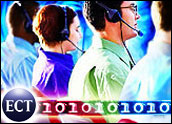
Contact consolidation is not for the lighthearted. For years, contact center management has been attempting to control costs by reducing the number of agents, physical sites and consolidating software and hardware solutions. Often these attempts are in conflict with customer and corporate demands. So, how do we increase contact center availability? Improve customer satisfaction? Reduce operational costs?
In an effort to address this dichotomy, we have seen contact centers go through a number of phases. First there was the “how many people can fit in a building” phase. Contact center management thought that information-sharing and operational efficiencies would improve by doing this. This phase was soon disrupted by the need to provide 24/7 coverage and the availability of lower cost options offshore.
As the walls of the contact center began to erode, another issue reared its ugly head: How do we get the right agent to address the customer’s issue? When intelligent routing came to the fore and it enabled companies to rout calls to the agent best-equipped to deal with them. However, the proliferation of sites also brought with it new challenges. Technology incompatibilities’ arose between sites and the ability to maintain and share accurate data became an even greater issue.
Hence, came the next phase. Would it be possible to create a virtual technology platform that spanned multiple sites and provide a platform that enabled the level of integration contact centers now required? The Aberdeen March 2008 benchmark “Contact Center Consolidation” looks at these issues and identifies the technologies required to support this transition.
Developing a Baseline Platform
The contact center requires certain building blocks. Best-in-Class companies lead the way when implementing mainstays such as IVR (interactive voice response) and ACD, or automatic call distributor (71 percent and 88 percent, respectively). Without these technologies to manage and route information, calls and customers, contact centers today simply could not exist.
However, as the world evolved, new technologies were required to support distributed contact centers. VoIP (voice over Internet protocol) provides companies with a flexible, cost-effective way to address the needs of the distributed agent population. Sixty-three percent of Best-in-Class companies have implemented VoIP. Without VoIP, companies would be unable to provide the level of service their customers have come to demand. Twenty-seven percent of all companies surveyed have home agents in place today, and twenty-plus percent are outsourcing some component of there customer support. VoIP is the key enabler for these types of support.
Best-in-Class companies are quickly moving to a virtual world. Survey data shows that 54 percent of Best-in-Class companies are in the process of providing virtual contact center resources on a single logical platform. The key technology enabler for this is multi-tenancy support. Being able to house multiple organizations and/or companies while keeping data and applications separate is critical to the success of the virtual contact center. Sixty-one percent of Best-in-Class companies currently have a multi-tenant platform in place.
The Building Blocks
Consolidation improves a corporation’s ability to manage its IT resources. Forty-five percent of Best-in-Class companies were able to improve the efficiency of their IT staffs and rapid application deployment as a result of consolidating resources. In support of this, Best-in-Class firms (61 percent) have also focused on standardizing their software applications. Improved access to the resources reduces contact center downtime, and new product functionality becomes available faster.
Contact centers need to have the building blocks in place and begin planning for the future. Contact centers should do the following:
- SIP (session initiation protocol): Get it and drink the Kool-Aid. This is the technology platform of the future and the key to the virtual world. Your technology and contact center teams need to understand how to deploy, manage and use it.
- Multi-tenancy: It doesn’t just happen. Multi-tenancy needs to be designed from the ground up. Make sure your vendors have it in place. The security of your data (and your customers) depends upon it.
Alan Hubbard is senior vice president of the customer service and support practice atAberdeen Group. He can be reached at [email protected].



















































